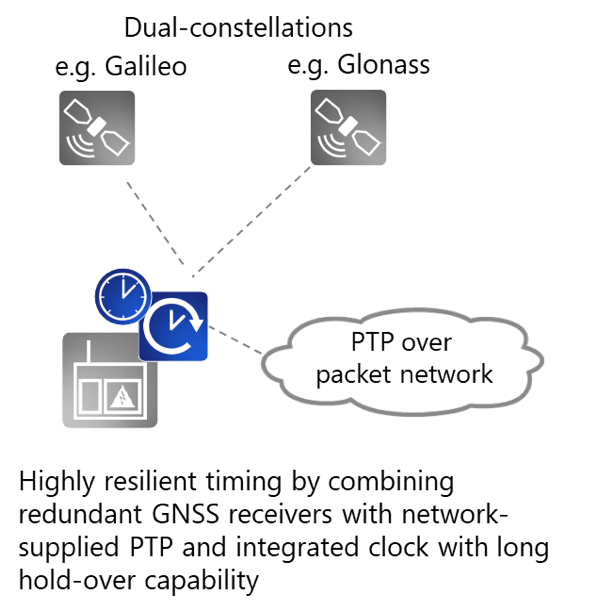For enterprises, network operators and governmental organizations, information technologies play a crucial role in business and operational processes. But an increasing number of these applications require very precise synchronization, as shown with the following examples:
- Regulators require financial institutions to precisely timestamp transactions
- Mobile network operators need to synchronize their base station for the most efficient use of radio spectrum
- Governments operate large data centers and need accurate time information for efficient synchronization of data
- Power utilities use timestamped power measurements for fast localization of failures
Without access to accurate time, the operation of those enterprises, communication networks and governmental organizations is at risk. That’s why highly available and precise synchronization has become a matter of national interest.
GNSS for satellite-based timing
Global navigation satellite systems (GNSS) emit signals that enable highly precise synchronization of clocks. In large networks, several thousand or even tens of thousands of GNSS receivers are used for local timing with an accuracy of 100ns and better. Mass deployment makes this a very cost-efficient solution that can be applied everywhere and rolled out very fast. There’s only one requirement: the GNSS antenna needs to have line of sight to several GNSS satellites.
Satellite-based timing, however, suffers from major risks:
- Temporary obstruction of GNSS antennas by buildings, trees or other barriers
- Interference of low-power GNSS signals by unintended or malicious jamming
- Performance impairments by GNSS spoofing attacks
- Unavailability of GNSS systems

Mitigating GNSS risk
Today, many networks, enterprise operations and even the operational systems of critical infrastructure depend on satellite-based timing. The failure scenarios listed above can cause tremendous damage. What’s more, failures or disturbances might not even be recognized immediately but only once services are affected. Countermeasures must be applied.
There are different ways to improve satellite-based timing, including real-time monitoring, proactive fault detection and methods for mitigating GNSS outages:
- GNSS-receivers with spoofing- and jamming-detection can identify problems at a very early stage
- Multi-band, multi-constellation GNSS receivers can avoid compromised frequencies and constellations by utilizing multiple bands and/or other constellations
- Clocks in GNSS receivers with long hold-over capability can enable a GNSS receiver to provide accurate timing even during extended periods of disturbed GNSS signals
- Centralized management systems monitor performance of GNSS signals and correlate this across a network for real-time quality assurance and initiation of countermeasures as soon as disturbances are identified
- Artificial intelligence and machine learning can identify problems in the synchronization network by analyzing network-wide performance data
- Network-based timing can be applied to back-up satellite-based timing
Making satellite-based timing highly reliable
The measures listed above all address the shortcomings of GNSS signals for the synchronization of mission-critical networks. A combination of satellite-based and network-based timing with high-performance oscillators can address those problems, forming the basis of highly available and very accurate synchronization solutions. IEEE 1588 grandmasters with boundary clock capabilities combine GNSS receivers and PTP functionality with precise clocks. Complemented by a sophisticated management system, timing accuracy is monitored and assured in real time. Any degradation is identified immediately, and counteraction is initiated before services are affected.

The following components are recommended for highly resilient synchronization solutions:
- Multi-band, multi-constellation GNSS receivers featuring
- Redundancy with dual receivers and two GNSS antennas
- Oscillators with standard and extended hold-over capabilities
- GNSS spoofing and jamming detection
- A family of scalable grandmasters applying such GNSS-receivers
- Comprising SFP-based edge devices for zero-footprint
- Rack-mountable edge grandmasters with multiple oscillator options
- Combining GNSS with Cesium atomic clock for enhanced primary time clocks (ePRTC)
- Modular, shelf-based solution for highly scalable core grandmaster
- Management solution with comprehensive assurance capabilities
- Monitoring synchronization quality and representing information with user-friendly GUI
- Predictive maintenance by analyzing performance data with deep learning algorithms
- Correlating device information about jamming and spoofing
Oscilloquartz solution portfolio
The Oscilloquartz synchronization solution portfolio provides the most comprehensive portfolio of PTP grandmasters with hardened, multi-band GNSS receivers. Our SFP-based OSA 5401 synchronizes applications without the need for a co-located additional synchronization device. For space-restricted applications, our OSA 5405 grandmaster integrates a dual, multi-constellation GNSS-receiver with antenna. Our scalable edge grandmaster OSA 5410/20 families effectively combine advanced multi-constellation GNSS receiver technology with a range of oscillators and modular line cards to meet the stringent timing accuracy needs of both legacy and next-generation applications. Our OSA 5430/40 families of multi-technology telecom grade fully redundant grandmasters integrate multi-band and multi-constellation GNSS receivers. In addition, they also support multiple high-speed 1 and 10Gbit/s interfaces and can be used for accurate packet-based timing as well as legacy TDM synchronization.

All Oscilloquartz products are managed by our Ensemble Controller management solution and our Ensemble Sync Director. These feature a graphical user interface that provides easy and transparent access to any information. Ensemble Sync Director uses artificial intelligence and machine learning to analyze performance information, identifies any adverse activities such as antenna obstruction, jamming or spoofing and triggers action for assuring the highest quality of synchronization network. What’s more, advanced deep learning algorithms are applied for root cause failure analysis.
